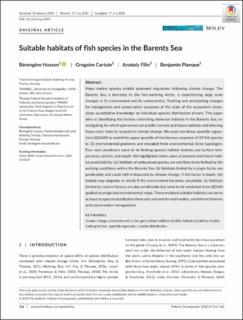| dc.description.abstract | Many marine species exhibit poleward migrations following climate change. The Barents Sea, a doorstep to the fast‐warming Arctic, is experiencing large scale changes in its environment and its communities. Tracking and anticipating changes for management and conservation purposes at the scale of the ecosystem necessitate quantitative knowledge on individual species distribution drivers. This paper aims at identifying the factors controlling demersal habitats in the Barents Sea, investigating for which species we can predict current and future habitats and inferring those most likely to respond to climate change. We used non‐linear quantile regressions (QGAM) to model the upper quantile of the biomass response of 33 fish species to 10 environmental gradients and revealed three environmental niche typologies. Four main predictors seem to be limiting species habitat: bottom and surface temperature, salinity, and depth. We highlighted three cases of present and future habitat predictability: (a) Habitats of widespread species are not likely to be limited by the existing conditions within the Barents Sea. (b) Habitats limited by a single factor are predictable and could shift if impacted by climate change. If the factor is depth, the habitat may stagnate or shrink if the environment becomes unsuitable. (c) Habitats limited by several factors are also predictable but need to be predicted from QGAM applied on projected environmental maps. These modeled suitable habitats can serve as input to species distribution forecasts and end‐to‐end models, and inform fisheries and conservation management. | en_US |
